 |
 |
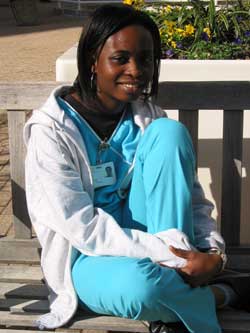
|
|
Kevilin Prah, Respiratory Therapist, Washington Hospital Center, Washington D.C.
|
1. I chose this career because...
2. My typical workday involves...
3. What I like best/least about my work...
4. My career goals are...
5. When I'm not working, I like to...
6. Skills for the job...
|
|
1. I chose this career because...
|
Back to Top

|

|
|
Kevilin at her desk in the NIH Office of Science Education where she worked part-time while going to college.
|
I chose to become a respiratory therapist because I heard about the right program at the right time. I always wanted to have a profession in the medical field and considered going to medical school. In high school, I always liked science, especially biology. When my grandmother was diagnosed with diabetes and lost her eyesight so quickly, it was a great motivator. I wanted to understand more about how the body becomes ill and also how it heals. My mother has worked as a nurse now for over twenty years. So I thought about testing out the medical field by going into nursing. It was my way to ensure that the medical field was right for me.
I was accepted into the University of the District of Columbia (UDC), but not into the nursing program right away. You have to meet certain requirements and successfully complete certain courses before acceptance into the nursing program. While waiting to register for the nursing program, a career counselor told me about the Health Career Opportunity Program (HCOP).
The program allowed a focus on one of two paths: speech pathology or respiratory therapy. I registered for the two-year respiratory therapy program, which included course work and clinical training. I completed the program and graduated in May, 2005. Currently, I work as a certified respiratory therapist at the Washington Hospital Center (http://www.whcenter.org/).
My Internship
While going to undergraduate school, I worked part-time at the NIH, Office of Science Education (http://science.education.nih.gov/) as an assistant coordinator for the Howard Hughes Medical Institute and Montgomery County Public School Student Teacher Internship program (http://www.mcps.k12.md.us/departments/intern/stp/). It places high school students and teachers in NIH laboratories to gain first-hand experience in research. I believe this experience helped me gain entrance into the UDC program.
College Education
Pre-requisites for Medical School, Montgomery College, Rockville, Maryland
Associate of Arts, Respiratory Therapy, Nursing and Allied Health Program, University of the District of Columbia (http://www.udc.edu/), Washington D.C.
Certification
After graduation you must take your certification exam (http://www.nbrc.org/ExamsCRT.htm) from National Board of Respiratory Care (NBRC, http://www.nbrc.org/default.html). This exam makes you qualified to work in the field. After successful completion, you are a Certified Respiratory Therapist (CRT).
After following additional guidelines (http://www.nbrc.org/rrt_admission.htm) you can take the registry exam (http://www.nbrc.org/ExamsRRT.htm) to become a Registered Respiratory Therapist (RRT).
|
|
2. My typical workday involves...
|
Back to Top

|
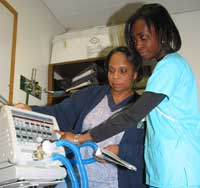
|
|
Kevilin reviews the basic settings on the T-Bird Ventilator with one of her supervisors, Lisa Zackery (Clinical Supervisor).
|
My typical workday revolves around administering respiratory care to patients in the hospital.
Currently, I’m scheduled to work two nights a week, and every other weekend.
Patient Assignments
When I get to work, I receive a printed assignment that lists the patients I need to see. The assignment includes the patient’s history, hospital admission information, and the respiratory care (treatment or medication) they are getting. I also get reports on these patients from the previous respiratory therapist(s) who were assigned to them in other work shifts. Their report will note the time they saw the patient, any changes in the care plan, any major allergies or reactions to medication and how to address that problem, and any specific orders for respiratory care from the physician.
Major duties and responsibilities include:
- Assessing the patient by listening to their breath sounds
- Giving patients their medication or other respiratory care treatment
- Educating patients on the respiratory care aspects of their disease and what their medication is doing to improve their breathing
Other procedures and responsibilities include:
- Draw blood for an arterial blood gas analysis that helps us to determine how well the patient’s blood is oxygenated. If necessary, we can modify the care plan based on the results.
- Care for patients that are intubated or on a ventilator to support their breathing. I have to monitor these patients very closely. Their care includes changing pressures on the ventilator per doctor’s order, suctioning their airway to remove any secretions, and administering medications such a bronchodialator to help them breath better.
- Interact and communicate with staff doctors, nurses, nurse practitioners and those in the pharmacy department about the respiratory care of my patients.
|
|
3. What I like best/least about my work...
|
Back to Top

|
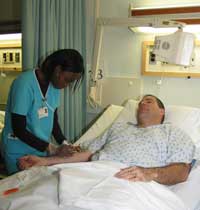
|
|
Kevilin draws blood from a patient using a blood gas kit which measures the amount of oxygen in the blood.
|
What I like best about my work is the great satisfaction I get from my job. When it comes to breathing, it’s everything. It plays a major role in carrying oxygen to the rest of our body. It means a lot to me to help someone with an asthma attack breath easier by giving him/her a bronchodilator and some oxygen. It is also very gratifying to be able to treat someone who has suddenly stopped breathing in a way that supports his or her life. The best part of my work is knowing that each day I’m responsible for making my patients feel better and breath easier.
What I like least about my work is not being able to help a patient in an emergency situation and the end result is death. A challenging part of my work is caring for non-compliant patients who refuse any form of treatment or care provided. In this work you can't procrastinate or put-off treatment until another day.
|
|
4. My career goals are...
|
Back to Top

|
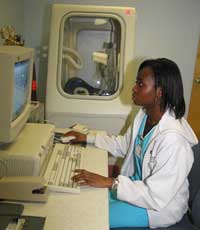
|
|
Kevilin uses the Pulmonary Function Testing Machine (or Body Box) which is a pressurized chamber used to measure the amount of air in a patient's lungs during different stages of respiration.
|
My career goals are to go to medical school and specialize in pulmonology. I think that being a respiratory therapist is preparing me for that step. I’m currently enrolled in a Bachelor of Science degree program at the University of the District of Columbia, studying biology. In 5-10 years from now, I hope to be in medical school, if everything goes as planned.
|
|
5. When I'm not working, I like to...
|
Back to Top

|
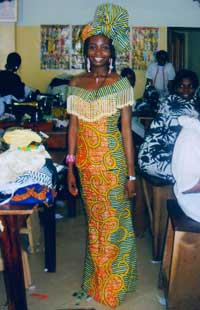
|
|
Kevilin wearing the traditional dress of Ghana on a recent trip to that country.
|
When I’m not working, I like to read novels, watch movies and even cartoons, listen to music – slow jazz, soulful gospel, and my music from Ghana. I also like going to the movies with friends and family. I enjoy trying to keep up with the current science, such as learning how we are using new information in the field of genetics to treat deadly diseases.
When I’m not working or in school, I like to travel to different countries. I recently went to Ghana, after 10 years of living in the states, to visit my family, relax and enjoy the beautiful weather. I also went to London to experience the European culture.
|
|
6. Skills for the job...
|
Back to Top

|
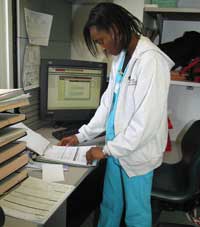
|
|
| |
Kevilin reviews patient charts on paper and on the computerized patient database.
|
I believe I have skills that make me well suited to being a respiratory therapist, such as:
- Communication- Communication is important in every profession. My work requires me to document all treatments and patient care information. I must also communicate with my patient for him/her to thoroughly understand the type of care I’m giving. Likewise, I have to communicate well with the rest of the healthcare team.
- Organization - I have to be able to organize my thoughts well about the information I get on my patient. This is important so that I ask the right questions and determine the best method of treatment.
- Observation-Observation is very important because you have to look, feel and listen to your patient during assessments. How well this is done will determine the method of treatment and care for your patient.
To me, respecting your colleagues and patients is also an important characteristic to have in this career. In the hospital, we all depend on the information our colleagues pass down to us when caring for our patients. Respecting their judgment, opinions and input is very important.
|
|
|
|
 |